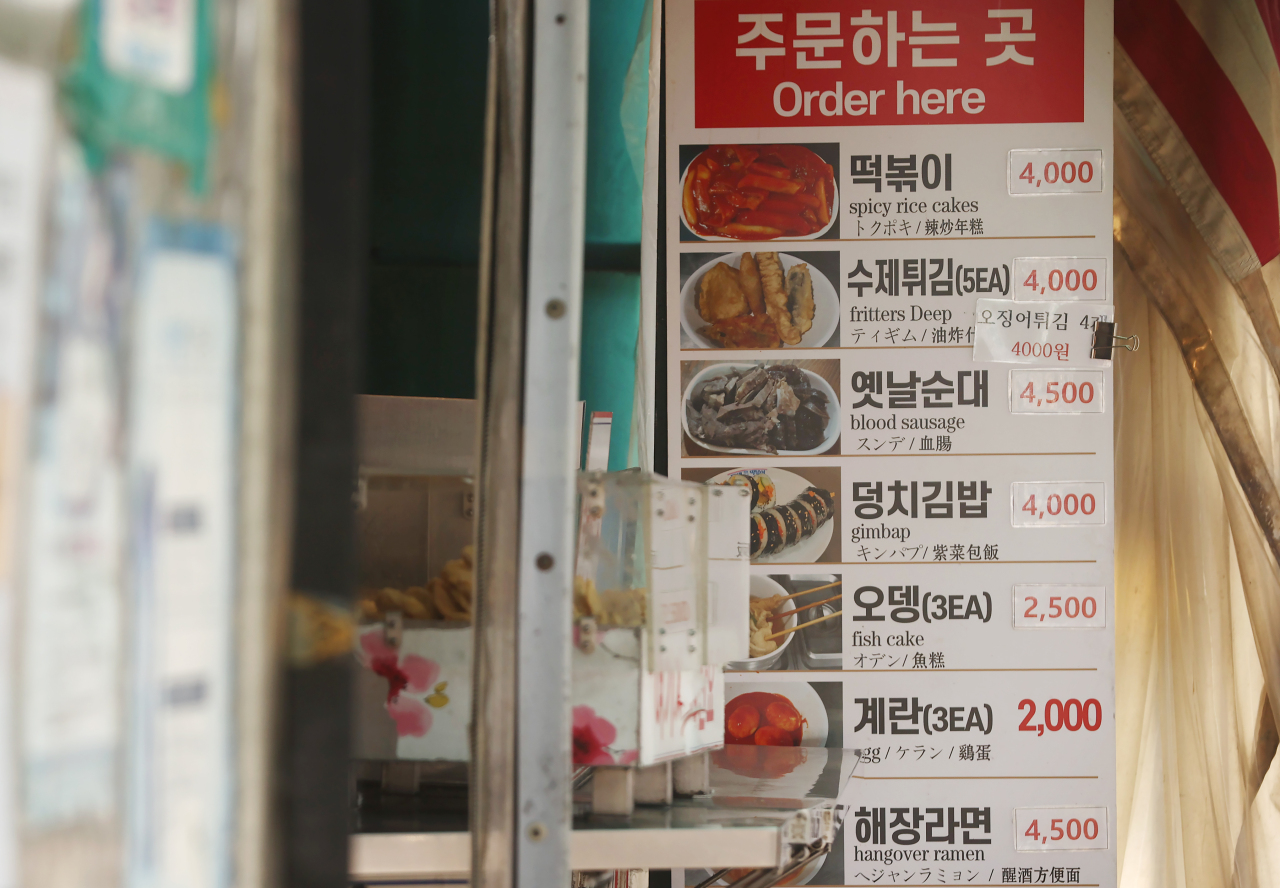
A standing signboard at a snack bar in Seoul shows hikes in price tags on food. (Yonhap)
SEJONG -- The Ministry of Economy and Finance said Tuesday that it would expand the rate of tax cut on fuel from the current 20 percent to 30 percent, temporarily from May to July, as a contingency plan to alleviate inflationary pressure.
The measure, aimed at easing the cost burden on households and some businesses, was unveiled amid growing concerns over consumer price growth reaching the highest figure in more than 10 years.
Announcing the plan at a ministerial meeting, Deputy Prime Minister and Finance Minister Hong Nam-ki stressed that “the consumer price is a very important, sensitive matter, which is directly linked to the disposable income of households.”
In the case of an ordinary driver commuting 40 kilometers a day with gas mileage of 10 kilometers per liter, they could save 30,000 won ($24.80) a month, policymakers explained. Compared to a cut by 20 percent, a 30 percent fuel tax cut will eases the cost burden by 10,000 won a month.
The measure also included support for the transportation and logistics industry.
The government will provide buses, freight trucks and cargo ships fuel-linked subsidies to a certain portion over the corresponding May-July period. The upper ceiling of the subsidies is set at 183.21 won per liter.
Simultaneously, the charge on sales of liquefied petroleum gas will be slashed by 30 percent for the three months to support taxi drivers and the self-employed.
In addition, the government -- to cope with a spike in international raw materials prices -- will levy a “zero percent” quote tariff on some materials used for assembly of secondary batteries and automobiles.
Hong said Russia’s invasion of Ukraine has caused an unexpected effect on consumer prices in the nation, adding that “major developed countries are also suffering prices growth up to 6-7 percent.”
According to Statistics Korea on the same day, consumer prices claimed 4.1 percent in March compared to a year earlier. This marked the highest figure in more than a decade, since on-year growth reached 4.2 percent in December 2011.
After posting a figure in the 3 percent range (3.2 percent) for the first time in about nine years in October 2021, consumer prices climbed 3.8 percent in November, 3.7 percent in December, 3.6 percent in January and 3.7 percent in February.
Figures for the period of January-September 2021 ranged between 0.9 percent and 2.6 percent. It was just 1.9 percent in March 2021.
Last month, petroleum products led the increases with growth of 31.2 percent, while that figure for February was 19.4 percent. Last month, a 37.9 percent surge was seen in the price of diesel, 27.4 percent in gasoline and 20.4 percent in LPG.
Since the nation suffered a 35.5 percent spike in petroleum prices in July 2008, growth in the 30 percent range was reported for the first time in 13 years in November 2021 at 35.5 percent. It was 31.2 percent in March 2022.
Prices of livestock climbed 7.6 percent on-year, with imports up by 27.7 percent, pork by 9.4 percent and domestic beef by 3.6 percent. The price of bread rose 9 percent.
Dining out for sashimi and chicken delivery climbed by 10 percent and 8.3 percent, respectively. Power and water fees rose by 5 percent and 4.1 percent, respectively.
By region, Jeju Province topped the list among the 17 major cities and provinces with consumer price growth of 5.1 percent. Gangwon and North Gyeongsang provinces were next at 4.9 percent.
Growth of 3.5 percent was reported in Seoul, with 4.2 percent in Gyeonggi Province and 4.4 percent in Sejong.
By Kim Yon-se (kys@heraldcorp.com)

![[Exclusive] Korean military set to ban iPhones over 'security' concerns](http://res.heraldm.com/phpwas/restmb_idxmake.php?idx=645&simg=/content/image/2024/04/23/20240423050599_0.jpg&u=20240423183955)




![[Pressure points] Leggings in public: Fashion statement or social faux pas?](http://res.heraldm.com/phpwas/restmb_idxmake.php?idx=645&simg=/content/image/2024/04/23/20240423050669_0.jpg&u=)